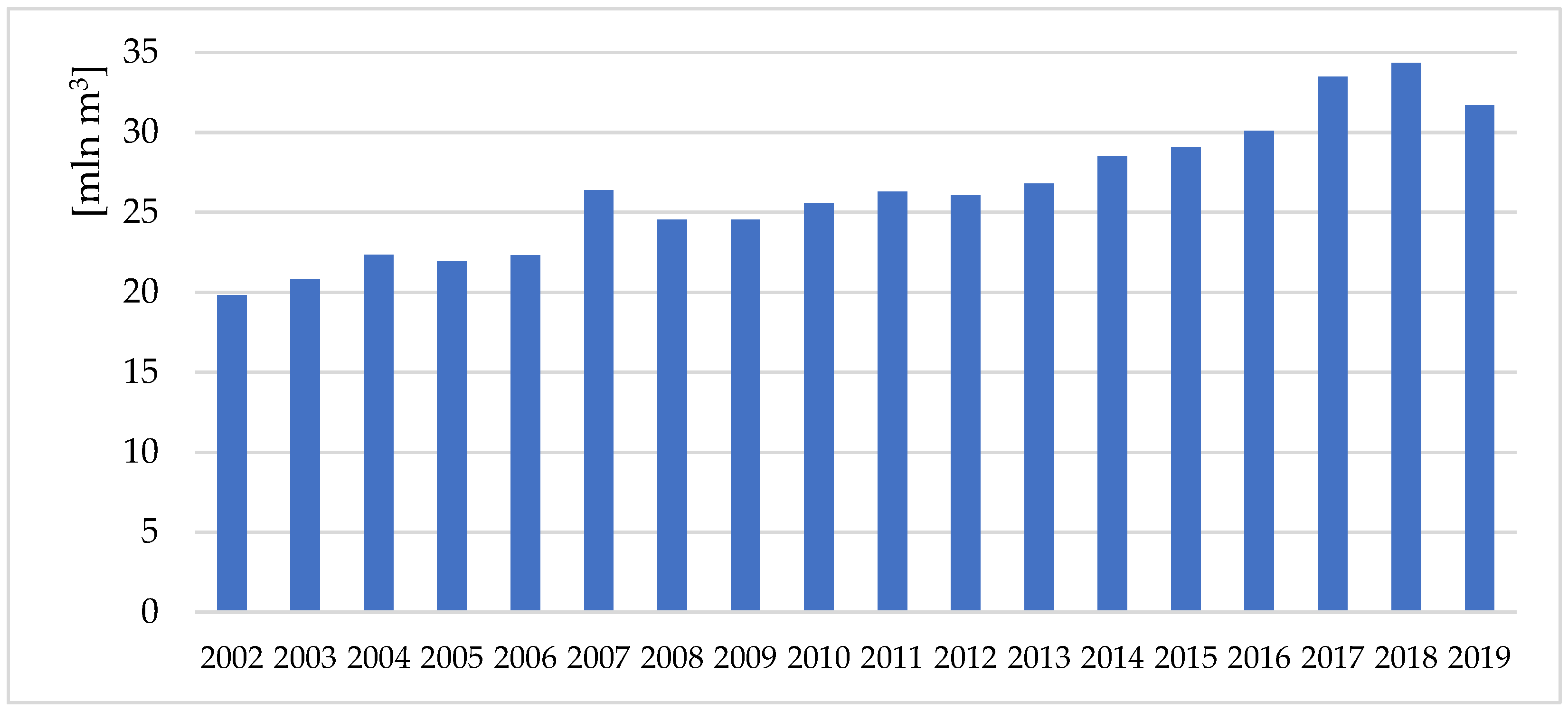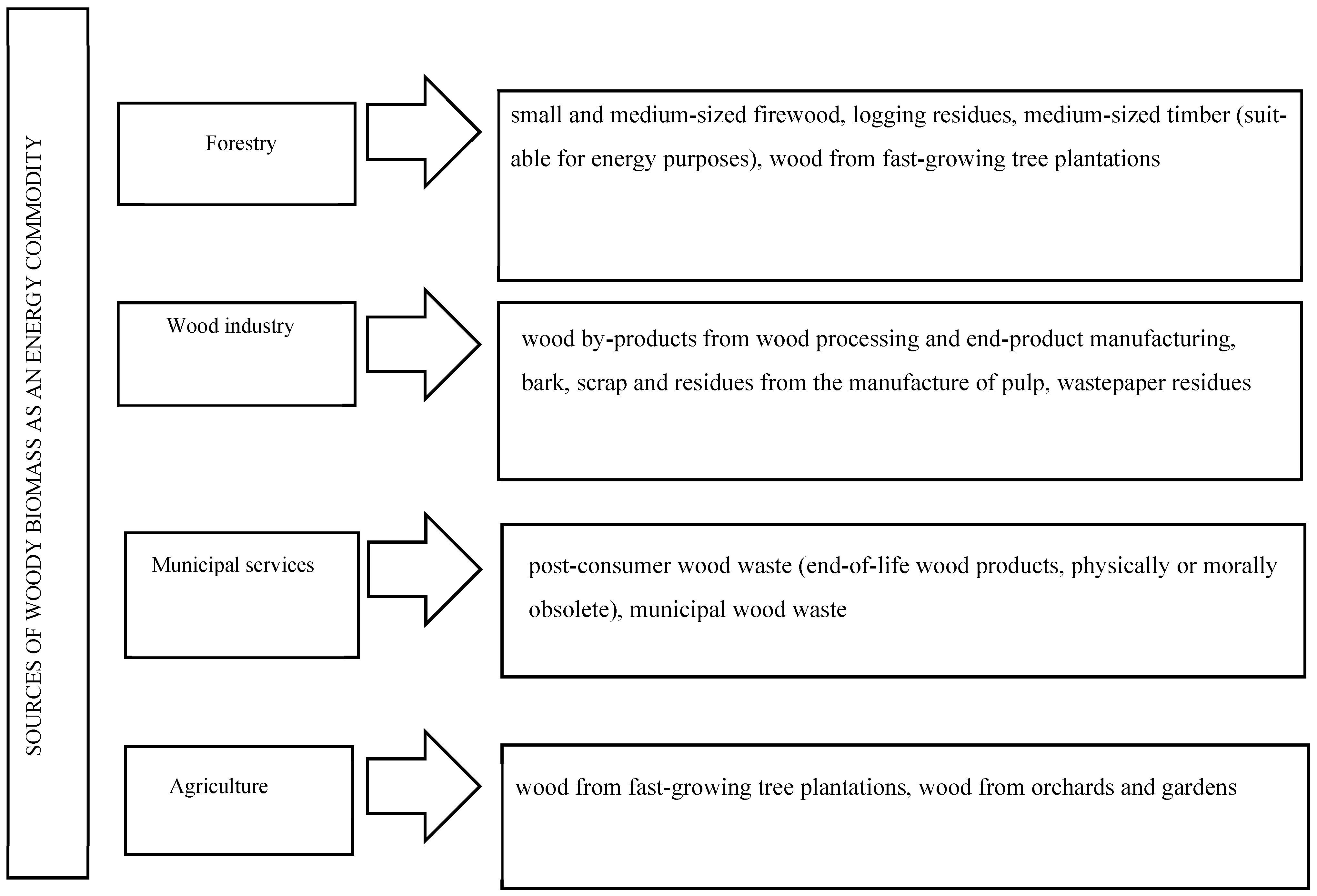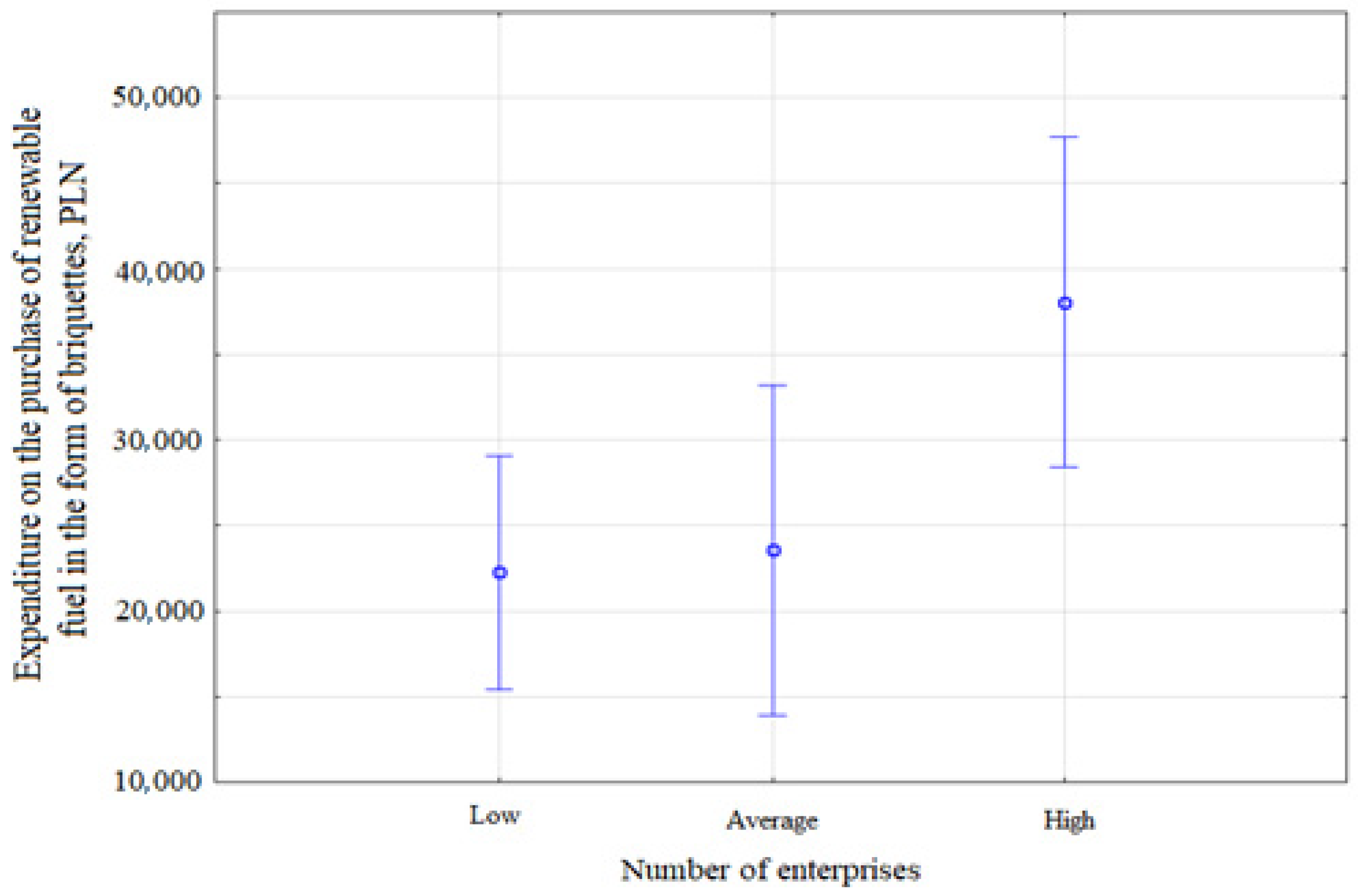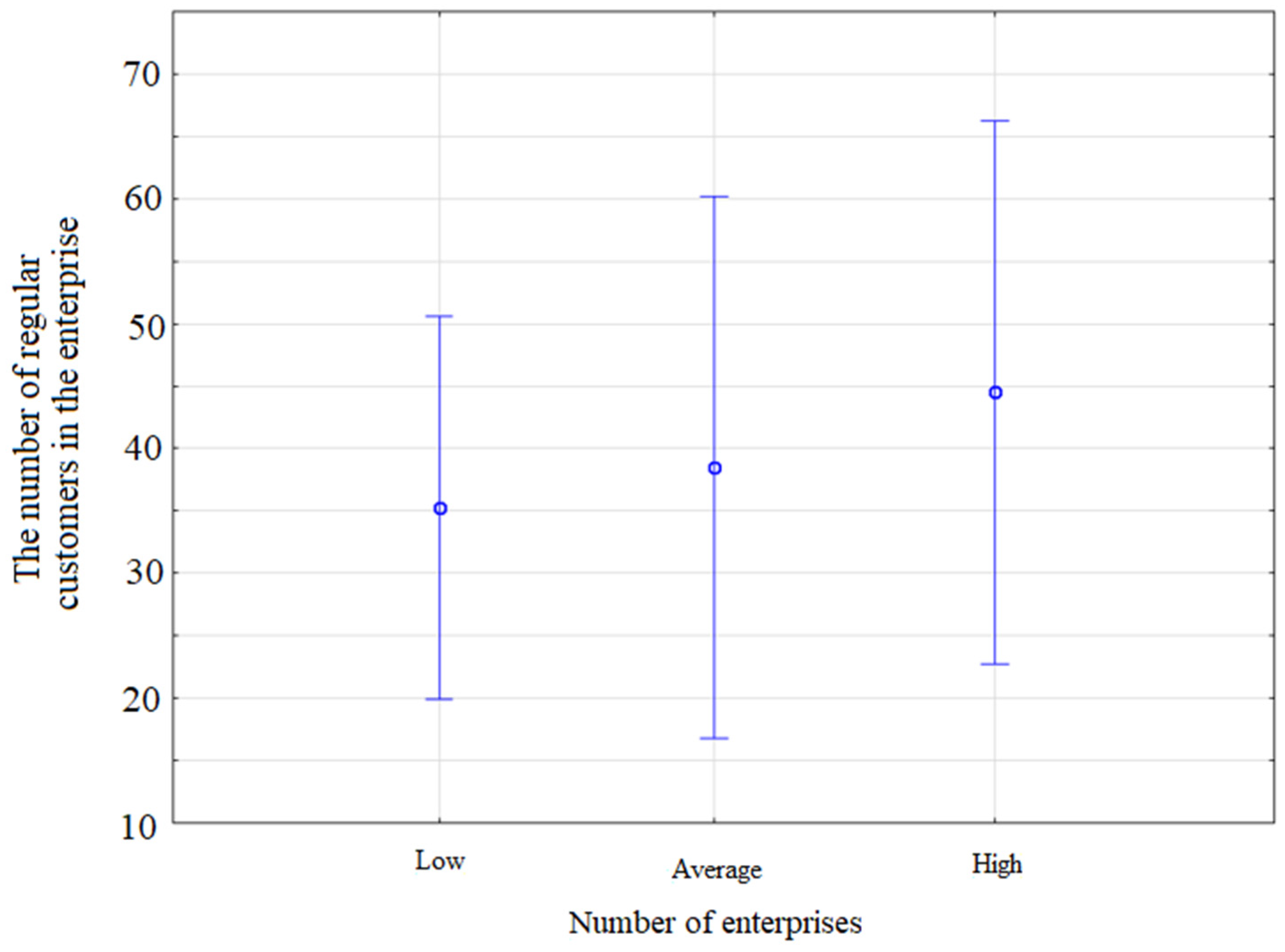Obtaining Forest Biomass for Energy Purposes as an Enterprise Development Factor in Rural Areas
Abstract
:1. Introduction
2. Literature Review
- Input vector X, which includes all factors of production;
- Output vector Y, which includes products, services, and various types of harmful waste;
- Input vector through processes into the output vector, called the production process;
- System management process;
- Material, energetic and informational interfaces between the above-mentioned components of the production system.
3. Research Objectives and Methodology
3.1. Using ANOVA to Measure the Selected Factors
- mi—The number of units in each group;
- a—The number of groups compared in the analysis of variance, the number of levels of the factor;
- —The overall mean, for all observations;
- —The mean average for a given level of the factor, for the study group;
- SST—The sum of squares between the subjects and between the groups;
- dfT—Degrees of freedom between the subjects and between the groups;
- MST—Between-group variance.
- Xsr—Overall mean, for the entire population;
- ai—The effect of factor A at level i (i = 1, 2, ..., n);
- bi—The effect of factor B at level i (i = 1, 2, ..., k);
- ck—The effect of factor C at level i (i = 1, 2, ..., m);
- (ab)ij—Interaction effect of factors A and B at levels i and j, respectively;
- (ac)ik—Interaction effect of factors A and C at levels i and k, respectively;
- (bc)jk—Interaction effect of factors B and C at levels j and k, respectively;
- (abc)ijk—Interaction effect of factors A, B and C at levels i, j and k, respectively;
- eijkl—Random error with normal distribution, mean equal to zero and constant variance.
3.2. Using the AHP Method for Factor Analysis
4. Results
5. Conclusions and Discussion
Author Contributions
Funding
Institutional Review Board Statement
Informed Consent Statement
Data Availability Statement
Conflicts of Interest
References
- Lin, B.; Lin, J. Evaluating energy conservation in China’s heating industry. J. Clean. Prod. 2017, 142, 501–512. [Google Scholar] [CrossRef]
- Dyrektywa 2003/87/WE Parlamentu Europejskiego i Rady z Dnia 13 Października 2003 r. Ustanawiająca System Handlu Przydziałami emisji Gazów Cieplarnianych We Wspólnocie Oraz Zmieniająca Dyrektywę Rady 96/61/WE s. 631. Available online: https://eur-lex.europa.eu/legal-content/PL/TXT/PDF/?uri=CELEX:32003L0087&from=pl (accessed on 15 June 2021).
- Bureau, D.P.; Kaushik, S.J.; Cho, C.Y. Bioenergetics. In Fish Nutrition, 3rd ed.; Elsevier: Amsterdam, The Netherlands, 2003; pp. 1–59. [Google Scholar] [CrossRef]
- Buttgereit, F.; Burmester, G.R.; Brand, M.D. Bioenergetics of immune functions: Fundamental and therapeutic aspects. Immunol. Today 2000, 21, 194–199. [Google Scholar] [CrossRef]
- Dziennik Ustaw Nr 261, poz. 2187 z Dnia 19 Grudnia 2005 r. w Sprawie Szczegółowego Zakresu Obowiązków Uzyskania i Przedstawienia do Umorzenia Świadectw Pochodzenia, Uiszczenia Opłaty Zastępczej, Zakupu Energii Elektrycznej i Ciepła Wytworzonych w Odnawialnych źródłach Energii, §2 ust. 1. Available online: http://isap.sejm.gov.pl/isap.nsf/download.xsp/WDU20052612187/O/D20052187.pdf (accessed on 15 June 2021).
- Blicharska, M.; Angelstam, P.; Elbakidze, M.; Axelsson, R.; Skorupski, M.; Węgiel, A. The Polish Promotional Forest Complexes: Objectives, implementation and outcomes towards sustainable forest management? For. Policy Econ. 2012, 23, 28–39. [Google Scholar] [CrossRef]
- Fang, J.; Chen, A.; Peng, C.; Zhao, S.; Ci, L. Changes in Forest Biomass Carbon Storage in China between 1949 and 1998. Science 2001, 292, 2320–2322. [Google Scholar] [CrossRef] [PubMed]
- Kalinowski, M.; Huz, M. Rozwój Metodyki Badań i Projektowania Rozwiązań Praktycznych w Zakresie Wykorzystania Biomasy Leśnej do Celów Energetycznych; Synteza Instytut Badawczy Leśnictwa: Sękocin Stary, Poland, 2010; pp. 5–6. [Google Scholar]
- Jensen, P.D.; Mattson, J.E.; Kofman, P.D.; Klausner, A. Tendency of wood fuels from whole trees, logging residues and roundwood to bridge over openings. Biomass Bioenergy 2004, 26, 107–113. [Google Scholar] [CrossRef]
- Malinen, J.; Pesonen, M.; Maatta, T.; Kajanus, M. Potential harvest for wood fuels (energy wood) from logging residues and first thinnings in Southern Finland. Biomass Bioenergy 2001, 20, 189–196. [Google Scholar] [CrossRef]
- Ollson, B.A.; Akerblom, S.; Bishop, K.; Eklof, K.; Rin, E. Does the harvest of logging residues and wood ash application affect the mobilization and bioavailability of trace metals? For. Ecol. Manag. 2017, 383, 61–72. [Google Scholar] [CrossRef]
- Wasiak, A. Raport o Stanie Lasów w Polsce; Lasy Państwowe; Centrum Informacyjne Lasów Państwowych: Warszawa, Poland, 2013; pp. 1–103. [Google Scholar]
- Zastocki, D.; Moskalik, T.; Sadowski, J.; Lisiecki, J. Wybrane wskaźniki techniczno-ekonomiczne pozyskania drewna na przykładzie Nadleśnictwa Radzyń Podlaski w latach 2006–2012. Stud. Mater. Cepl. Rogowie 2014, 16, 216–223. [Google Scholar]
- Główny Urząd Statystyczny w Warszawie, Bank Danych Lokalnych. Available online: https://bdl.stat.gov.pl/BDL/start (accessed on 12 January 2021).
- Jarvinen, T.; Agar, D. Experimentally determined storage and handling properties of fuel pellets made from torrefied whole-tree pine chips, logging residues and beech stem wood. Fuel 2014, 129, 330–339. [Google Scholar] [CrossRef]
- Jonsell, M.; Hansson, J.; Wedmo, L. Diversity of saproxylic beetle species in logging residues in Sweden—Comparisons between tree species and diameters. Biol. Concervation 2007, 138, 89–99. [Google Scholar] [CrossRef]
- Iwald, J.; Lofgren, S.; Stendahl, J.; Karltun, E. Acidifying effect of removal of tree stumps and logging residues as compared to atmospheric deposition. For. Ecol. Manag. 2013, 290, 49–58. [Google Scholar] [CrossRef]
- Dwivedi, P.; Bailis, R.; Khanna, M. Is Use of Both Pulpwood and Logging Residues Instead of Only Logging Residues for Bioenergy Development a Viable Carbon Mitigation Strategy? Bioenergy Res. 2014, 7, 217–231. [Google Scholar] [CrossRef]
- Kubiak, M.; Różański, H. Charakterystyka techniczna rębnych drzew i drzewostanów sosnowych pod kątem mechanizacji prac pozyskaniowych. In Dokumentacja AR-IBL; Warszawa, Poland, 1985; p. 23. [Google Scholar]
- Варес, В.; Каськ, Ю.; Муисте, П.; Пиху, Т.; Сooсаар, С. Справoчник пoтребителя биoтoплива [Poradnik użytkownika biopaliwa]. Таллиннский технический университет. Таллинн 2005, 147. [Google Scholar]
- Nurek, T.; Gendek, A.; Roman, K. Forest Residues as a Renewable Source of Energy: Elemental Composition and Physical Properties. BioResources 2018, 14, 6–20. [Google Scholar] [CrossRef]
- Grosse, T.; Hardt, Ł. Sektorowa czy Zintegrowana, czyli o OPTYMALNEJ Strategii Rozwoju Polskiej wsi; Pro Oeconomica-Fundacja Ewaluacji i Badań Ekonomicznych: Warszawa, Poland, 2011. [Google Scholar]
- Kłodziński, M. Dywersyfikacja gospodarki ważnym celem polityki wiejskiej. In Uwarunkowania Ekonomiczne Polityki Rozwoju Polskiej wsi i Rolnictwa; Drygas, M., Zawalińska, K., Eds.; IRWiR PAN: Warszawa, Poland, 2012. [Google Scholar]
- Mölders, T. Multifunctional agricultural policies: Pathways towards sustainable rural development? Int. J. Soc. Agric. Food 2014, 21, 97–114. [Google Scholar]
- Sattler, C.; Nagel, U.J. Factors affecting farmers’ acceptance of conservation measures—A case study from north-eastern Germany. Land Use Policy 2010, 27, 70–77. [Google Scholar] [CrossRef]
- Zegar, J.S. Ekonomika rolnictwa versus ekonomia agrarna. In Wieś i Rolnictwo w Procesie Zmian. Rolnictwo w Nowym Otoczeniu Rynkowym i Instytucjonalnym; Bisaga, S.A., Ed.; Wydawnictwo Uniwersytetu Opolskiego: Opole, Poland, 2010; pp. 13–24. [Google Scholar]
- Zając, D. Znaczenie Pozarolniczej Działalności Gospodarczej Rolników w Procesie Rozwoju Wielofunkcyjności Rolnictwa i Obszarów Wiejskich; Prace Naukowe Wydziału Ekonomii Uniwersytetu Rzeszowskiego, Seria: Monografie i Opracowania 17; Wydawnictwo Uniwersytetu Rzeszowskiego: Rzeszów, Poland, 2014. [Google Scholar]
- Czubak, W. Rozwój Rolnictwa w Polsce z Wykorzystaniem Wybranych Mechanizmów Wspólnej Polityki Rolnej Unii Europejskiej; Wydawnictwo Uniwersytetu Przyrodniczego w Poznaniu: Poznań, Poland, 2013. [Google Scholar]
- Tocco, B.; Bailey, A.; Davidova, S. Determinants to Leave Agriculture and Change Occupational Sector; Evidence from Enlarged EU; Univertisty of Kent, School of Economics: Seville, Spain, 2013. [Google Scholar]
- Rosner, A. Zróżnicowanie przestrzenne obszarów wiejskich a pożądane kierunki ich rozwoju. In Obszary Wiejskie. Wielofunkcyjność. Migracje. Nowe Wizje Rozwoju; Kamińska, W., Heffner, K., Eds.; STUDIA KPZK PAN, Tom CXXXIII: Warszawa, Poland, 2011. [Google Scholar]
- Wilkin, J. Wielofunkcyjność rolnictwa—Nowe ujęcie roli rolnictwa w gospodarce i społeczeństwie. In Wielofunkcyjność Rolnictwa. Kierunki Badań, Podstawy Metodologiczne i Implikacje Praktyczne; Wilkin, J., Ed.; IRWiR PAN: Warszawa, Poland, 2010. [Google Scholar]
- Poulsen, M.; Spiker, M. Integrating Urban Farms into the Social Landscape of Cities. Recommendations for Strengthening the Relationship between Urban Farms and Local Communities; Johns Hopkins Bloomberg School of Public Health: Baltimore, MD, USA, 2014. [Google Scholar]
- Stanny, M.; Rosner, A.; Komorowski, Ł. Monitoring Rozwoju Obszarów Wiejskich. Etap III. Struktury Społeczno-Gospodarcze, ich Przestrzenne Zróżnicowanie i Dynamika; EFRWP, IRWiR PAN: Warszawa, Poland, 2018. [Google Scholar]
- Trojak, M. Regionalne Zróżnicowanie Rozwoju Ekonomicznego Polski (Differences in Economic Development between POLISH REGIONS); Publishing House of the Jagiellonian University: Krakow, Poland, 2013. [Google Scholar]
- Roman, M.; Roman, M.; Prus, P.; Szczepanek, M. Tourism Competitiveness of Rural Areas: Evidence from a Region in Poland. Agriculture 2020, 10, 569. [Google Scholar] [CrossRef]
- Antoneli, V.; Pulido-Fernández, M.; Bednarz, J.A.; Brandes, L.; Vrahnakis, M.; Kazoglou, Y.; Lozano-Parra, J.; García-Marín, R. Changes in Water Quality of the River das Antas as It Passes through Rural and Urban Areas. Urban. Sci. 2021, 5, 22. [Google Scholar] [CrossRef]
- Schelisch, L.; Walter, R. Digital Networking in Home-Based Support of Older Adults in Rural Areas: Requirements for Digital Solutions. Sustainability 2021, 13, 1946. [Google Scholar] [CrossRef]
- Schimmenti, E.; Viola, E.; Funsten, C.; Borsellino, V. The Contribution of Geographical Certification Programs to Farm Income and Rural Economies: The Case of Pecorino Siciliano PDO. Sustainability 2021, 13, 1977. [Google Scholar] [CrossRef]
- Roman, M.; Roman, M. Milk Market Integration between Poland and the EU Countries. Agriculture 2020, 10, 561. [Google Scholar] [CrossRef]
- Lahmar, R. Adoption of conservation agriculture in Europe: Lessons of the KASSA project. Land Use Policy 2010, 27, 4–10. [Google Scholar] [CrossRef]
- Halamska, M.; Stanny, M.; Wilkin, J. Ciągłość i Zmiana. Sto lat Rozwoju Wsi Polskiej (Continuity and Changes. A Centenary of Rural Development in Poland); SCHOLAR Scientific Publishing House, Institute of Rural and Agricultural Development of the Polish Academy of Sciences: Warsaw, Poland, 2019. [Google Scholar]
- Duarte, A.; Northcote, J. Investigating farmers’ involvement in value-added activities: A preliminary study from Australia. Br. Food J. 2013, 115, 1407–1427. [Google Scholar] [CrossRef]
- Wojcieszak, M. Uwarunkowania Rozwoju Turystyki Przyrodniczej na Obszarach Metropolitalnych i Jego Efekty Ekonomiczne (Conditions for, and Economic Effects of, the Development of Nature Tourism in Metropolitan Areas); Publishing House of the Poznan University of Life Sciences: Poznań, Poland, 2017. [Google Scholar]
- Yang, Y. Understanding tourist attraction cooperation: An application of network analysis to the case of Shanghai. J. Destin. Mark. Manag. 2017, 8, 396–411. [Google Scholar] [CrossRef]
- Kiryluk-Dryjska, E.; Beba, P.; Poczta, W. Local determinants of the Common Agricultural Policy rural development funds’ distribution in Poland and their spatial implications. J. Rural Stud. 2020, 74, 201–209. [Google Scholar] [CrossRef]
- Zając, S. Badania wpływu gospodarki leśnej na ekonomiczno-społeczny rozwój kraju—Cele, metody, wyniki. Poznańskie Towarzystwo Przyjaciół Nauk. Wydział Nauk Rolniczych i Leśnych. For. Lett. 2013, 104, 74–86. [Google Scholar]
- Staniszewski, P. Uwarunkowania Budowy Systemu Niedrzewnego Użytkowania Lasu. Rozprawy Naukowe i Monografie, Seria 425; Wydawnictwo SGGW: Warszawa, Poland, 2013; ISBN 978-83-7583-458-1. [Google Scholar]
- Degórski, M. Infrastrukturalna wartość lasów. Lasy w zagospodarowaniu przestrzennym i kształtowaniu krajobrazu; społeczno-kulturowe wartości lasu w przestrzeni (w środowisku życia człowieka). In Lasy jako Czynnik Rozwoju Cywilizacji: Współczesna i Przyszła Wartość Lasów; Panel ekspertów; Instytut Badawczy Leśnictwa: Sękocin Stary, Poland, 2013. [Google Scholar]
- Sultana, A.I.; Saha, N.; Reza, M.T. Synopsis of Factors Affecting Hydrogen Storage in Biomass-Derived Activated Carbons. Sustainability 2021, 13, 1947. [Google Scholar] [CrossRef]
- IIASA. Study on Impacts on Resource Efficiency of Future EU Demand for Bioenergy; International Institute for Applied Systems Analysis (IIASA): Laxenburg, Austria, 2016. [Google Scholar]
- Lauri, P.; Havlík, P.; Kindermann, G.E.; Obersteiner, M. Woody biomass energy potential in 2050. Energy Policy 2017, 66, 19–31. [Google Scholar] [CrossRef]
- Petersson, H.; Holm, S.; Ståhl, G.; Alger, D.; Fridman, J.; Lehtonen, A.; Lundström, A.; Mäkipää, R. Individual tree biomass equations orbiomass expansion factors for assessment of carbon stock changes in livingbiomass—A comparative study. For. Ecol. Manag. 2012, 270, 78–84. [Google Scholar] [CrossRef] [Green Version]
- Kraxner, F.; Nordström, E.M.; Havlík, P.; Gusti, M.; Mosnier, A.; Frank, S.; Valin, H.; Fritz, S.; Fuss, S.; Kindermann, G.; et al. Global bioenergyscenarios—Future forest development, land-use implications, and trade-offs. Biomass Bioenergy 2013, 57, 86–96. [Google Scholar] [CrossRef]
- Ince, P.; Kramp, A.; Skog, K. Evaluating economic impacts of expanded globalwood energy consumption with USFPM/GFPM model. Can. J. Agric. Econ. 2012, 60, 211–237. [Google Scholar] [CrossRef]
- Jabłoński, M.; Budniak, P. Szacowanie nadziemnej biomasy drzewnej lasów w Polsce na potrzeby sprawozdaczości EKG/FAO i UNFCCC. For. Res. Pap. 2014, 75, 277–289. [Google Scholar]
- Ratajczak, E.; Bidzińska, G. Rynek Biomasy Drzewnej na cele Energetyczne—Aspekty Ekonomiczne i Społeczne; Biomasa leśna na cele energetyczne; Gołos, P., Kaliszewki, A., Eds.; Instytut Badawczy Leśnictwa: Sękocin Stary, Poland, 2013. [Google Scholar]
- Bijak, S.; Zasada, M.; Bronisz, A.; Bronisz, K.; Czajkowski, M.; Ludwisiak, Ł.; Tomusiak, R.; Wojtan, R. Estimating coarse roots biomass in young silver birch stands on post-agricultural lands in central Poland. Silva. Fenn. 2013, 47, 1–14. [Google Scholar] [CrossRef]
- Persson, T. Environmental consequences of tree stump harvesting. For. Ecol. Manag. 2013, 290, 1–4. [Google Scholar] [CrossRef]
- Walters, J.P.; Archer, D.W.; Sassenrath, G.F.; Hendrickson, J.R.; Hanson, J.D.; Halloran, J.M.; Vadas, P.; Alarcon, V.J. Exploring agricultural production systems and their fundamental components with system dynamics modelling. Ecol. Model. 2016, 333, 51–65. [Google Scholar] [CrossRef] [Green Version]
- Durlik, I. Inżynieria Zarządzania cz.1.; Wydawnictwo Placet: Warszawa, Poland, 2007. [Google Scholar]
- Biazzo, S.; Bernardi, G. Process management practices and quality systems standards: Risks and opportunities of the new ISO 9001 certification. Bus. Process. Manag. J. 2003, 9, 149–169. [Google Scholar] [CrossRef]
- Zhang, Q.; Lu, X.; Peng, Z.; Ren, M. Perspective: A review of lifecycle management research on complex products in smart-connected environments. Int. J. Prod. Res. 2019, 57, 6758–6779. [Google Scholar] [CrossRef]
- Szostak, A. Drzewne Produkty Uboczne Źródłem Biomasy Drzewnej do Celów Energetycznych; Biomasa leśna na cele energetyczne; Gołos, P., Kaliszewki, A., Eds.; Instytut Badawczy Leśnictwa: Sękocin Stary, Poland, 2013. [Google Scholar]
- Kamimura, K.; Kuboyama, H.; Yamamoto, K. Wood biomass supply costs and potential for biomass energy plants in Japan. Biomass Bioenergy 2012, 36, 107–115. [Google Scholar] [CrossRef]
- Walker, T.; Cardellichio, P.; Gunn, J.S.; Saah, D.S.; Hagan, J.M. Carbon Accounting for Woody Biomass from Massachusetts (USA) Managed Forests: A Framework for Determining the Temporal Impacts of Wood Biomass Energy on Atmospheric Greenhouse Gas Levels. J. Sustain. Forestry 2013, 32, 130–158. [Google Scholar] [CrossRef]
- Field, B.C.; Campbell, J.E.; Lobell, D.B. Biomass Energy: The scale of the potential resource. Trends Ecol. Evol. 2008, 23, 65–72. [Google Scholar] [CrossRef]
- Gust, J.; Gundolf, K.; Cesinger, B. Doing business in a green way: A systematic review of the ecological sustainability entrepreneurship literature and future research directions. J. Clean. Prod. 2017, 147, 44–56. [Google Scholar] [CrossRef]
- Kahan, D. Entrepreneurship in Farming; Food and Agriculture Organization of the United Nations: Rome, Italy, 2012; Available online: https://www.cabdirect.org/cabdirect/abstract/20133384542 (accessed on 13 April 2021).
- Jakubowski, J.; Sztencel, R. Wstęp do Teorii Prawdopodobieństwa; Script: Warszawa, Poland, 2004. [Google Scholar]
- Statystyka na Piechotę. Available online: http://home.agh.edu.pl/~bartus/index.php?action=statystyka&subaction=przedzialy_ufności (accessed on 12 January 2021).
- Wzory na Jednoczynnikową Analizę Wariancji. Available online: http://www.naukowiec.org/wzory/statystyka/jednoczynnikowa-analiza-wariancji_371.html (accessed on 12 January 2021).
- Miller, G.A. The Magic Number Seven Plus or Minus Two Some Limits on our Capacity for Processing Information. Psychol. Rev. 1956, 63, 343–352. [Google Scholar] [CrossRef] [Green Version]
- Saaty, R.W. The Analytic Hierarchy Process—What it is and how it is used. Math. Model. 1987, 9, 161–176. [Google Scholar] [CrossRef] [Green Version]
- Rycąbel, C. Metoda wyboru rodzaju piętrzenia wody dla celów energetyki rolniczej. Inżynieria Rol. 2001, 8, 349–360. [Google Scholar]
- Pankaj, L.; Alavalapati, J.R.R.; Marinescu, M.; Rao Matta, J.; Dwivedi, P.; Susaeta, A. Developing Sustainability Indicators for Woody Biomass Harvesting in the United States. J. Sustain. For. 2011, 30, 736–755. [Google Scholar]
- Lauri, P.; Kallio, M.; Schneider, U. Price of CO2 emissions and use of wood in Europe. Policy Econ. 2012, 15, 123–131. [Google Scholar] [CrossRef]
- Gołos, P.; Kaliszewki, A. Biomasa Leśna na Cele Energetyczne; Instytut Badawczy Leśnictwa: Sękocin Stary, Poland, 2013. [Google Scholar]
- Nurek, T.; Gendek, A.; Roman, K.; Dąbrowska, M. The effect of temperature and moisture on the chosen parameters of briquettes made of shredded logging residues. Biomass Bioenergy 2019, 130, 105368. [Google Scholar] [CrossRef]
- Schnorf, V.; Trutnevyte, E.; Bowman, G.; Burg, V. Biomass transport for energy: Cost, energy and CO2 performance of forest wood and manure transport chains in Switzerland. J. Clean. Prod. 2021, 293, 125971. [Google Scholar] [CrossRef]
- Hoyne, S.; Thomas, A. Forest Residues: Harvesting, Storage and Fuelvalue, Dublin. 2015. Available online: https://www.cabdirect.org/cabdirect/abstract/20023126149 (accessed on 12 March 2021).







| Item | Properties | Reference |
|---|---|---|
| 1 | - longitudinal thickness: 64% | [19] |
| - stacked thickness: 8% | ||
| - general limb: 5% | ||
| - brushwood: 7% | ||
| - roots: 16% | ||
| 2 | - wood arrows: 61% | [20] |
| - bark arrows: 8% | ||
| - branches: 12% | ||
| - needles: 3% | ||
| - snag: 16% | ||
| 3 | - treetops, branches, needles: 20% | [20] |
| - branches thinner than 40 mm and needles: 15% | ||
| - branches thicker than 40 mm: 5% * | ||
| 4 | - trunk 69% | [21] |
| - treetop, branches 16% | ||
| - stump, roots 15% |
| Voivodeship | Number of All Enterprises in the Voivodeships | Number of Enterprises Surveyed | Coniferous Timber Acquisition, m3 | Sales of Renewable Fuel Briquettes to Selected Customers (SME) (PLN) | Number of Regular Customers in the Enterprises Surveyed |
|---|---|---|---|---|---|
| Dolnośląskie | 2541 | 40 | 2,760,541 | 24,333.4 | 22 |
| Kujawsko-pomorskie | 1628 | 26 | 2,428,896 | 27,516.5 | 59 |
| Lubelskie | 1521 | 24 | 1,332,704 | 38,115.4 | 37 |
| Lubuskie | 1005 | 16 | 3,050,218 | 15,579.6 | 28 |
| Łódzkie | 2078 | 33 | 1,170,489 | 26,045.8 | 72 |
| Małopolskie | 5943 | 93 | 864,462 | 31,444.0 | 24 |
| Mazowieckie | 5095 | 80 | 1,865,031 | 55,008.5 | 49 |
| Opolskie | 1007 | 15 | 1,054,616 | 10,504.8 | 13 |
| Podkarpackie | 2285 | 36 | 1,583,928 | 21,122.9 | 30 |
| Podlaskie | 1008 | 16 | 1,626,952 | 26,673.5 | 63 |
| Pomorskie | 2154 | 34 | 4,801,999 | 22,720.0 | 30 |
| Śląskie | 4552 | 71 | 1,308,918 | 24,756.4 | 36 |
| Świętokrzyskie | 1059 | 16 | 1,108,281 | 17,491.7 | 20 |
| Warmińsko-Mazurskie | 1105 | 17 | 2,669,944 | 22,360.0 | 46 |
| Wielkopolskie | 4661 | 73 | 3,336,411 | 41,042.1 | 69 |
| Zachodniopomorskie | 1533 | 24 | 3,388,714 | 19,849.3 | 16 |
| Importance Degree | Explanation |
|---|---|
| 1 | Both elements have the same weight |
| 3 | The first element is slightly more important than the second |
| 5 | The first element is much larger than the second |
| 7 | The first element is much more important than the second |
| 9 | The first element is decisively more important than the second |
| Output Parameter | Factors |
|---|---|
| Number of enterprises—subclass 16.29.Z, Manufacture of other wood products Grouping factor: • Low, <20 enterprises in the voivodeship; • Average, 20–40 enterprises in the voivodeship; • High, >40 enterprises in the voivodeship. | Coniferous timber acquisition, (in m3) |
| Sales of renewable fuel briquettes to selected customers (small and medium companies—SME) (in PLN) | |
| Number of regular customers in the enterprises surveyed—Average number of customers (pieces) |
| Number of Enterprises | Homogeneous Group Based on Duncan’s Analysis | |
|---|---|---|
| 1 | 2 | |
| Low | X | |
| Average | X | |
| High | X | |
| Criteria Preferences | Sales of Renewable Fuel Briquettes to Selected Customers (PLN) | Coniferous Timber Acquisition | Number of Regular Customers in the Enterprises Surveyed |
|---|---|---|---|
| Sales of renewable fuel briquettes to selected customers (PLN) | 1 | 7 | 3 |
| Coniferous timber acquisition | 1/7 | 1 | 1 |
| Number of regular customers in the enterprises surveyed | 1/3 | 1 | 1 |
Publisher’s Note: MDPI stays neutral with regard to jurisdictional claims in published maps and institutional affiliations. |
© 2021 by the authors. Licensee MDPI, Basel, Switzerland. This article is an open access article distributed under the terms and conditions of the Creative Commons Attribution (CC BY) license (https://creativecommons.org/licenses/by/4.0/).
Share and Cite
Roman, K.; Roman, M.; Wojcieszak-Zbierska, M.; Roman, M. Obtaining Forest Biomass for Energy Purposes as an Enterprise Development Factor in Rural Areas. Appl. Sci. 2021, 11, 5753. https://doi.org/10.3390/app11125753
Roman K, Roman M, Wojcieszak-Zbierska M, Roman M. Obtaining Forest Biomass for Energy Purposes as an Enterprise Development Factor in Rural Areas. Applied Sciences. 2021; 11(12):5753. https://doi.org/10.3390/app11125753
Chicago/Turabian StyleRoman, Kamil, Michał Roman, Monika Wojcieszak-Zbierska, and Monika Roman. 2021. "Obtaining Forest Biomass for Energy Purposes as an Enterprise Development Factor in Rural Areas" Applied Sciences 11, no. 12: 5753. https://doi.org/10.3390/app11125753
APA StyleRoman, K., Roman, M., Wojcieszak-Zbierska, M., & Roman, M. (2021). Obtaining Forest Biomass for Energy Purposes as an Enterprise Development Factor in Rural Areas. Applied Sciences, 11(12), 5753. https://doi.org/10.3390/app11125753








